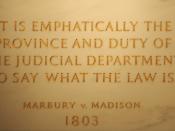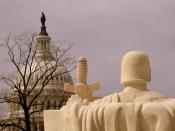BIBLIOGRAPHY INCLUDED AT THE END OF TEXT.
In 1803 the question of whether or not un-elected judges should have the power to overturn or limit the enforcements of any law that may conflict with the Federal Constitution arose in the case of Marbury v. Madison. This practice is referred to as judicial review and also applies to state laws that will possibly dispute with Federal laws or their own state constitution. The power of the courts to determine the constitutionality of a law is a necessity in the United States form of government. A debate has continuously raged throughout the United States since the power was established.
Federalist John Adams lost the Presidential election of 1800 to the leader of the Anti-Federalist party, Thomas Jefferson. The Judiciary Act of 1801 allowed Adams to appoint 42 justices of the peace. In order to get as many Federalists in office as he could, he appointed any man he saw fit.
Secretary of State John Marshall was to sign, seal, and deliver these appointments on the night of March 3rd, 1801. He failed, however, to deliver them. The day after Thomas Jefferson's inauguration he ordered James Madison, the new Secretary of State, to put a halt on 17 of the 42 commissions, including that of William Marbury. Mr. Marbury sued Mr. Madison in hopes of receiving a writ of mandamus, which would require Mr. Madison to give him the appointment. The court's decision in this case, written by James Madison, also the one who sealed Mr. Marbury's commission, established and justified judicial review. Marshall's decision on the case allowed the Supreme Court to brand Thomas Jefferson as a violator of civil rights instead of issuing an order that he, the President, could have simply ignored.
This case brought up many questions...


